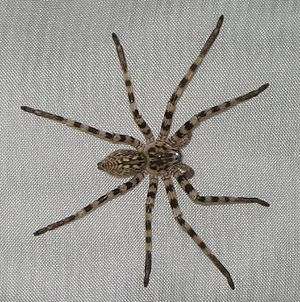Eusparassus walckenaeri
| Eusparassus walckenaeri | ||||||||||||
|---|---|---|---|---|---|---|---|---|---|---|---|---|

Eusparassus walckenaeri |
||||||||||||
| Systematics | ||||||||||||
|
||||||||||||
| Scientific name | ||||||||||||
| Eusparassus walckenaeri | ||||||||||||
| ( Audouin , 1826) |
Eusparassus walckenaeri is a species of spider inthe giant crab spider family . The species is the only representative of the genus found in the eastern Mediterranean.
description
Females of this large species reach a leg span of about 11 cm. Males stay a bit smaller and are much more delicate, but do not differ from the females in terms of coloration. The basic color of the entire body and legs is light beige to cream in color. The front part of the body ( prosoma ) shows large dark brown spots near the edge and a dark central band. The longitudinally oval rear body ( opisthosoma ) is laterally irregular, fine brown speckled or dashed and shows in the middle a brown, darkly delimited central band that becomes narrower towards the rear and ends in a series of fine transverse bands. The legs are broadly ringed in dark brown.
distribution and habitat
Eusparassus walckenaeri colonizes parts of the central and eastern Palearctic from Greece and eastern North Africa through the Near and Middle East to Afghanistan . The distribution area includes the subtropical to arid zone.
Way of life
The species creates up to palm-sized residential webs under stones or large branches, in which it spends the day. At night, the animals go hunting in the area and can then be found regularly in the populated area. The species climbs very well and is therefore regularly observed on house walls. Larger insects are likely to be the main prey.
According to observations in captivity, copulation is only preceded by a very short courtship by the male. After a few touches by the male, the female remains calm. The male then climbs "upside down" on the female's back so that it sits with its head pointing towards the female's spinnerets. The male then lets himself down to one side of the female and introduces his or her globe into the female's genital opening, after which it switches to the other side of the female and repeats the process there, whereby the left globe is inserted into the right sexual opening and vice versa . In one case, the female became active again about 10 minutes after copulation and drove the male away. A few weeks after copulation, the females lay an egg cocoon on the ceiling of their hiding place, which is guarded until the young spiders hatch. Then the female leaves the hiding place, the young spiders migrate after the first molt.
Existence and endangerment
The species is evidently quite common in its area of distribution, no information is available on a hazard.
Web links
Eusparassus walckenaeri in the World Spider Catalog
- G. Tansley: Rearing the giant huntsman spider Sparassus walckenaeri. Accessed July 12, 2010
literature
- Ulrich Gerhardt: Biological studies on Greek, Corsican and German spiders . In: Zoomorphology . tape 10 , no. 4 . Springer, December 1928, ISSN 0720-213X , p. 576-675 , doi : 10.1007 / BF00419324 .
- Ulrich Gerhardt: New studies on the sexual biology of spiders, especially on species from the Mediterranean countries and the tropics . In: Zoomorphology . tape 27 , no. 1 . Springer, March 1933, ISSN 0720-213X , p. 1-75 , doi : 10.1007 / BF00406040 .
Individual evidence
- ↑ The World Spider Catalog, V11.0 by NI Platnick . Research.amnh.org. May 21, 2010. Retrieved July 12, 2010.